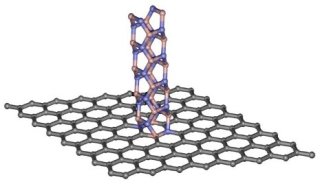Aug 3 2015
A team of researchers headed by Yoke Khin Yap, a Professor of Physics at Michigan Technological University, has worked to create digital switches by integrating graphene and boron nitride nanotubes.
 Physics professor Yoke Khin Yap says the chemical structures of graphene (gray) and boron nitride nanotubes (pink and purple) are key in creating a digital switch.
Physics professor Yoke Khin Yap says the chemical structures of graphene (gray) and boron nitride nanotubes (pink and purple) are key in creating a digital switch.
Graphene is often referred to as a wonder material due to its unique nature and numerous benefits. Boron nitride nanotubes are also a very beneficial material and can be manipulated for both biological and physical applications.
These two materials independently cannot be used in electronic applications. Graphene as a conductor allows very rapid flow of electrons without any control or restrictions. Boron nitride nanotubes on the hand are highly insulating causing electrons to be rebuffed. However, when these two materials are combined, they act as a workable digital switch. This switch is the key for controlling electrons in phones, computers, medical equipment and other electronics.
“The question is: How do you fuse these two materials together?” Yap says. The solution lies in exploiting their existing chemical structures to the maximum and utilizing their mismatched characteristics.
Nanoscale Tweaks
Basically, graphene can be defined as a molecule-thick sheet of carbon atoms, and nanotubes are similar to straws created from boron and nitrogen. Yap’s team exfoliated graphene and altered the surface of the material with minute pinholes. The idea is to allow the nanotubes to grow through these pinholes. The end result is to a meshed up material that resembles a flake of bark sprouting irregular, thin hairs.
“When we put these two aliens together, we create something better,” Yap says, illustrating that it is vital that these materials have lopsided band gaps, or variations in the amount of energy required to excite an electron in the material. “When we put them together, you form a band gap mismatch—that creates a so-called ‘potential barrier’ that stops electrons.”
The variation in band gap is caused due to the structure of the material. The flat sheets of graphene rapidly conduct electricity, while the atomic structure in the nanotubes stops electric current.
This difference develops an obstruction because of the variation in electron movement as currents travel adjacent to and past the boron nitride nanotubes. The points of contact between these two materials are referred to as heterojunctions. These heterojunctions make the digital on/off switch achievable.
“Imagine the electrons are like cars driving across a smooth track,” Yap says. “They circle around and around, but then they come to a staircase and are forced to stop.”
The research team has demonstrated that the switching ratio is high due to the materials being highly effective at conducting or stopping electricity. In simple words, the speed at which the materials can switch on and off is several orders of magnitude greater than current graphene switches. This speed could also cause an increase in the rate of computing and electronics.
Solving the Semiconductor Dilemma
The findings from Yap’s team research will probably help build faster and smaller computers in the future. Their study is a continuation of earlier research on building transistors without semiconductors.
Semiconductors like silicon can only be made small to an extent, and they transmit plenty of heat. These issues are overcome by the graphene and nanotube combination. Furthermore, both these materials possess the same lattice matching or atomic arrangement pattern. Issues of electron scattering are avoided in the graphene-nanotube digital switches because of the alignment of atoms.
“You want to control the direction of the electrons,” Yap explains,“This is difficult in high speed environments, and the electron scattering reduces the number and speed of electrons.” This can be compared to a pinball machine, which traps, reduces the speed and redirects the electrons.
Going forward, Yap and his team will be involved in finding methods to overcome or alter the pinball arrangement of graphene so as to reduce electron scattering. The possibility of faster computers and digital pinball games could very well become a reality.
Their findings have been published in the journal Scientific Reports.